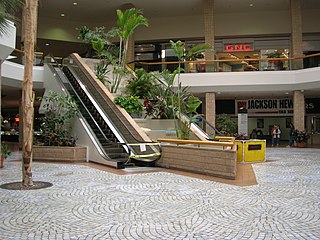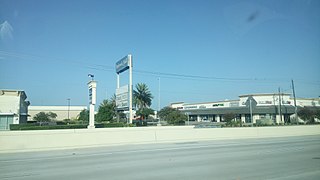
A strip mall, strip center or strip plaza is a type of shopping center common in North America where the stores are arranged in a row, with a sidewalk in front. Strip malls are typically developed as a unit and have large parking lots in front. Many of them face major traffic arterials and tend to be self-contained with few pedestrian connections to surrounding neighborhoods. Smaller strip malls may be called mini-malls, while larger ones may be called power centers or big box centers. In 2013, The New York Times reported that the United States had 65,840 strip malls. In 2020, The Wall Street Journal wrote that in the United States, despite the continuing retail apocalypse starting around 2010, investments and visitor numbers were increasing to strip malls.

Woodfield Mall is a shopping mall located in the northwest Chicago suburb of Schaumburg, Illinois, United States, at the intersection of Golf Road and Interstate 290. The mall is the largest shopping mall in the state of Illinois, the second largest being Oakbrook Center in Oak Brook. It is also one of the largest shopping malls in the United States.

The Northshore Mall is a shopping mall in Peabody, Massachusetts. As of 2022, the mall currently features Macy's in two locations, J. C. Penney, and Nordstrom.

Hillsdale Shopping Center, or simply Hillsdale, is a shopping mall in San Mateo, California, United States, currently anchored by Macy's and Nordstrom. Featuring over 130 stores and restaurants, it is at the intersection of Hillsdale Boulevard and El Camino Real or CA-82, adjacent to the Hillsdale Caltrain Station and the former site of Bay Meadows Racetrack. It is owned by Bohannon Development Co.

Valley View Center is a former mall located at Interstate 635 and Preston Road in north Dallas, Texas, U.S. It is owned and managed by Dallas-based Beck Ventures. The mall was formerly home to anchor stores that were once JCPenney, Macy's, Sears, and Dillard's. The demolition of the mall was completed in May 2023.

Cary Towne Center was an indoor shopping mall in Cary, North Carolina. It was anchored by Belk, Dillard's, Macy's, JCPenney, and Sears.

Sunrise Mall was a two-story, enclosed shopping mall in Corpus Christi, Texas. It is located at the intersection of Airline Rd. & S. Padre Island Drive. Current tenants include Planet Fitness, New Life Church, Freedom Fitness, and Little Woodrow's Bar.

Golf Mill Shopping Center, or simply Golf Mill, is a shopping mall located at 239 Golf Mill Center in Niles, Illinois. The shopping mall has a gross leasable area of 1.1 million square feet (100,000 m2). It is managed by Sterling Retail Services. It borders the intersections of Golf Road, Milwaukee Avenue and Greenwood Avenue. The shopping mall has over 100 specialty shops, three anchor stores, an AMC Theatres, a grocery store, an XSport Fitness gym, and a 9-story office tower and other outparcels. Former anchors included Sears and Roebuck, and Kohl's.

Baybrook Mall is a shopping mall located near the Clear Lake City area in Houston, Texas; It has a Friendswood mailing address, but it is in the Houston city limits. The mall is located off Interstate 45, and it is also in proximity to Webster and the NASA Johnson Space Center. The anchor stores are Star Cinema Grill, Dave & Buster's, Dillard's, JCPenney, H&M, Macy's, and Forever 21. There is 1 vacant anchor store that was once Sears.
Canyon Creek is a residential neighborhood located in far northwest Austin, Texas. The neighborhood is located in ZIP Code 78726 and is bordered by Ranch to Market Road 2222 (RM2222) on the south, Ranch to Market Road 620 North (RR620) on the west, Anderson Mill Road on the north, and a major headwater tributary of Bull Creek to the east as well as the Balcones Canyonlands National Wildlife Refuge. The wildlife refuge gives the neighborhood of over 1300 homes a semi-rural feeling despite being less than four miles to major shopping and employment centers. The major bisecting road is Boulder Lane, which winds its way through the picturesque, upper-middle-class neighborhood of single-family homes. Boulder Lane is a loop, and crosses RR620 in two places. The neighborhood is approximately 5 miles from Lake Travis and Lake Austin. Ranch Road 620 runs into the new toll roads of State Highway 45 at Lakeline Mall. Fast ways to get downtown is by taking 620 to 183 and going south. Another fast route is taking 620 to 2222 and then onto 360 to the left or the right. Left will take you to Gateway Theater on 183 and right will take you out to southern Austin and that is also a good route to the airport and San Antonio.

Barton Hills is a neighborhood in Austin, Texas. It is located in south Austin, and encompasses part of ZIP code 78704.
East Riverside-Oltorf is a neighborhood in Austin, Texas, located southeast of the city's urban core. The East Riverside, Parker Lane, and Pleasant Valley neighborhoods together form the East Riverside-Oltorf Combined Neighborhood Planning Area. The region is bounded on the north by Lake Lady Bird, to the east by Grove Boulevard and the Montopolis neighborhood, Texas State Highway 71 to the south, and Interstate 35 and South River City to the west.

The Arts & Entertainment District, or previously known as Omni, is a neighborhood of Downtown Miami, Florida. It is bound roughly by North 19th Street to the north, North 10th Street to the south, North West 2nd Avenue to the west, and Biscayne Boulevard to the east.
Westgate is a neighborhood in Austin, Texas, located southwest of the city's urban core. It includes ZIP code 78745.
Galindo is a neighborhood in Austin, Texas. The area covers part of ZIP code 78704 in south Austin.
Spyglass-Barton's Bluff is a neighborhood in Austin, Texas. It is located southwest of the city's urban core, and encompasses ZIP codes 78746 and 78704.
East César Chávez is a neighborhood in Austin, Texas. It is located in the central-east part of Austin's urban core on the north bank of the Colorado River. The neighborhood encompasses much of ZIP code 78702.
Austin Country Club is a private golf club in the southern United States, located in Austin, Texas. Established 124 years ago in 1899, the club moved to its third and present site in 1984, a challenging layout designed by noted course architect Pete Dye.
Los Altos Center is a regional shopping mall in the Los Altos area of northeastern Long Beach, California along Bellflower Boulevard, 4 miles south of Lakewood Center Mall and 5 miles east of Downtown Long Beach.
Blackland is a historically black neighborhood on the east side of Austin, Texas, located north of Martin Luther King, Jr. Blvd, south of Manor Road, east of I-35, and west of Chestnut Street. The neighborhood was originally known as Blacklands and was settled by Swedish immigrants, but evolved into a predominantly African-American neighborhood following the 1928 Austin city plan, which called for the relocation of non-white residents to the east side of the city. Up until the 1980s, the neighborhood was targeted for demolition to make way for an expansion of the University of Texas campus. In 1983, the Blackland Community Development Corporation was formed to build, purchase and maintain housing for low-income families and special populations.











